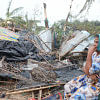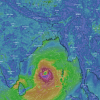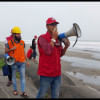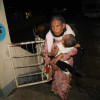Recovery from Mocha: Restoring and building resilience

Bangladesh has narrowly escaped massive damage from Severe Cyclone Mocha as it hit the coast of Myanmar, near Cox's Bazar, on Sunday afternoon. Although the extent of destruction in Bangladesh is not as much as it is in Myanmar, urgent attention is required at the recovery stage. Mocha was particularly damaging for Teknaf, St Martin's Island, and Ukhiya in Cox's Bazar. Receiving the cyclone forecast, the government, with the support of the Cyclone Preparedness Programme (CPP) put much effort into ensuring the safety of vulnerable people as per the Standing Orders on Disaster (SOD). The evacuation process was completed promptly and people living in vulnerable locations were taken to cyclone shelters. The initial actions were focused on saving lives through emergency responses.
Now comes the phase of recovery, involving repairing, reconstructing, and, in some cases, rehabilitating. According to media reports, at least 13,500 houses were affected in the chars of Cox's Bazar, St Martin's Island, and the nearby areas, including the Rohingya camps. However, the actual extent of damage caused by Mocha is yet to be evaluated, and is expected to be figured out by rapid need assessment (RNA) and damage and need assessment (DNA) processes.
Bangladesh's disaster management system, especially in the context of common disasters such as floods and cyclones, has been internationally acclaimed, which has once again been reflected in the preparation for Mocha. According to government officials, more than 1.2 million individuals were evacuated as part of the cyclone response. The Border Guard Bangladesh (BGB), police, and tourist police worked together to transport all tourists, including those in Cox's Bazar, to safe shelters. Special emphasis was put on the Rohingya camps in Cox's Bazar, where government protection initiatives had been set in operation. To combat flooding and landslides, 3,000 volunteers in the Rohingya camps had already been trained. Three mobile clinics and mobile units were formed to offer emergency assistance to protect the security of vulnerable populations such as women, children, and the elderly. These efforts place a higher priority on the welfare of women and children because they are more susceptible to disasters than anyone else. Volunteers, both women and men, worked in different facets of emergency response.
Currently, there are 76,144 trained volunteers along the shore, and remarkable initiatives have been implemented in flood-affected regions. It can be said that the emergency responses have been satisfactory, and there is no report of casualties, except a few people suffering minor injuries.
Technological advances, including the launch of Bangabandhu-1 Satellite, have substantially improved the weather forecasting system in the country. Flood warnings can now be sent out three to five days in advance, wherein mathematical models, remote sensing GIS radar, and satellite data analysis are used. The Bangladesh Meteorological Department (BMD) gives cyclone warnings 7-10 days in advance. Early warnings are broadcast on community radio stations, further enhancing preparedness.
Fortunately, people reacted positively to the government's preparedness ahead of the cyclone. People in the coastal region have become more aware over the last decade and follow the signals in the event of a disaster. However, there are still some people who disregard the risks posed by a disaster. There have been instances where visitors were seen taking selfies in Cox's Bazar and moving around to observe the cyclone out of curiosity. Some men said they were guarding boats and belongings, but had sent women and children to the shelters. Such behaviour not only endangers their safety, but also increases the administration's burden of ensuring a successful evacuation.
Now that the immediate threat has passed, attention must be paid to determine how much damage Cyclone Mocha has caused. It is crucial to guarantee that people who have been staying in the shelters can safely return home. Determining the amount of support and resources needed for recovery will depend on how the damage to crops, infrastructure, animals, and other essential elements of livelihood is assessed. Post-disaster recovery and rehabilitation initiatives should be given high priority to reconstruct from the damages incurred by Cyclone Mocha.
In the post-disaster stage, attention must be given to the affected population who have lost houses, standing crops, and livelihoods. The immediate requirement would be helping them in repairing and reconstructing their houses, reviving agricultural activities and/or finding alternative employment opportunities, and having access to safe drinking water.
As the coastal region is already suffering from salinity intrusion, an increase in rainwater harvesting, safe water preservation, and other practices has been observed. There are also some indigenous practices for water and food preservation that are followed by coastal people. As safe water scarcity is always a challenge in the coastal region, immediate attention should be given to safe drinking water management. Providing medical support to the injured, pregnant, ill people, elderly, and persons with disabilities must be given utmost importance as per the social inclusion agenda endorsed in the revised SOD 2019.
Cyclone Mocha offers evidence of the improvement made in our disaster management and preparedness in recent years. Lives were secured and damage was reduced because of the implementation of early warning systems, training of volunteers and their active participation, and improved forecasting technologies.
To "build back better" in post-cyclone periods, more collaborative efforts are essential at national, regional, and international levels. Bangladesh is following an inclusive, whole-of-society disaster risk reduction approach. However, the intersectionality approach needs to be mainstreamed to create more secure and resilient communities using the lessons learnt from Cyclone Mocha.
Dr Mahbuba Nasreen is pro-vice-chancellor (academic) at Bangladesh Open University, and co-founder and former director of the Institute of Disaster Management and Vulnerability Studies, Dhaka University.

 For all latest news, follow The Daily Star's Google News channel.
For all latest news, follow The Daily Star's Google News channel. 








Comments